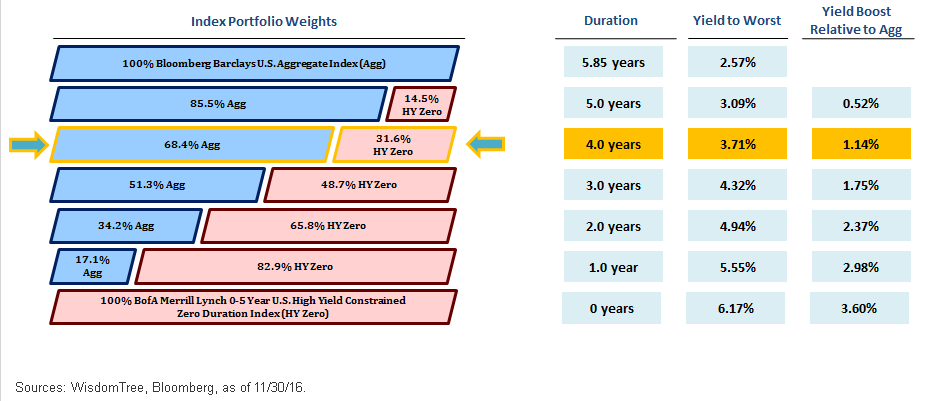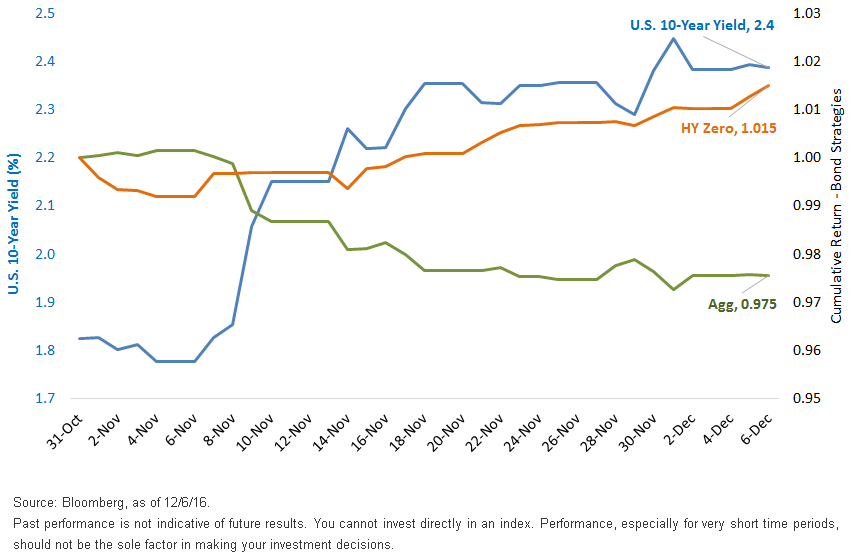Bond Portfolio Wish List: Hedge Duration, Pick Up Yield


Since the election, we’ve seen the stock markets embrace Donald Trump’s victory, with the S&P 500 rallying roughly 4% and the Dow Jones around 6%. While the surge in equities increased year-to-date returns by over 50% (6.7% to 10.5%)1 many bond investments went the other way, losing a sizable portion of what they had gained up to that point in the year. The Bloomberg Barclays U.S. Aggregate Index (Agg) represents broad U.S. investment-grade debt and had returned roughly 5% until the night of the election, but it has slumped roughly 2.3% since then. Given that the yield2 on the Agg was 2.59% at the beginning of the year, this move wipes out nearly an entire year’s worth of expected total return of the index.
Despite tacit acknowledgement of increasing interest rate risks in the bond markets, the severity of the two-week move and its consequences caught many investors by surprise. The 55 basis points (bps) move in the 10-Year Treasury yield is the third-largest move in the last 30 years. With interest rate moves like these, fixed income portfolios with even modest durations could get hurt, but the more duration, the more pain, with extraordinary low yields providing little protection.
In anticipation of drastic or unidirectional interest rate movements, bond investors typically choose to either dial up or down their duration profile. One common way to do this is using U.S. Treasury futures to hedge duration in a portfolio of high-yield or investment-grade bonds.
However, for many investors, constantly adjusting the hedge ratios for a portfolio can be cumbersome and out of their comfort zone. Fortunately, exchange-traded funds (ETFs) such as the WisdomTree BofA Merrill Lynch High Yield Bond Zero Duration Fund (HYZD), which tracks the BofA Merrill Lynch 0-5 Year US High Yield Constrained, Zero Duration Index (HY Zero), are designed to do just that. The strategy uses an institutional-style approach that combines long positions in short-term, high-yield bonds with a short position in Treasury securities to target zero duration.
Combining HY Zero with other bonds in a portfolio can help reduce the interest rate risk of the overall portfolio while potentially supplementing income levels. Most investors will likely not replace all of their existing holdings with duration-hedged strategies as it would require a complete overhaul. However, they can implement these strategies in a piecewise manner to target a desired duration for their overall portfolio. This is shown below, where HY Zero is layered into a broad portfolio, represented by the Agg.
Index Portfolio Weights, Duration, and Yield to Worst

The Agg has an intermediate duration of about 6.6 years with a yield of about 1.96%. Notice that to target, for example, a four-year duration, one could simply allocate a ratio of about 27% into HY Zero, with the remaining 73% being left in the Agg. Not only could this potentially reduce duration of the overall portfolio by roughly 24%, but it could increase the yield of the portfolio by 117 basis points (bps), or a 60% increase in total yield.
Further, implementing this strategy at increasing percentages could continue the effect of lowering duration and increasing yield.
So an interest rate-hedged or zero-duration portfolio of high-yield bonds has limited exposure to interest rate risk, with the return driven by credit risk. How did that work when the 10-Year yield jumped 45 bps post-election? The graph below shows what HY Zero and the Agg did if $1 was invested in either index at the beginning of November. Clearly, HY Zero outperformed, given its lack of sensitivity to interest rate risk.
U.S. Bonds Post-Election

While 45 bps moves in benchmark yields are not common, slow grinds upward in yields happen relatively often within the same market cycles. These marches upward in yields can happen over several months and can be greater than 100 bps in yield movements before turning back around. In environments like these, where the Federal Reserve is on a path of normalizing interest rates and the yield curve is taking notice, managing interest rate risk in bond portfolios should be top of mind for investors. Implementing strategies such as duration-hedged bond funds could be an effective tool in interest rate risk mitigation.
Unless otherwise noted, data source is Bloomberg, as of 12/6/16.
1Represents S&P500 returns Year-to-date as of 11/8/16 and 12/6/16.
2Yield to worst as of 12/31/16.
Important Risks Related to this Article
There are risks associated with investing, including possible loss of principal. High-yield or “junk” bonds have lower credit ratings and involve a greater risk to principal. Fixed income investments are subject to interest rate risk; their value will normally decline as interest rates rise. The Fund seeks to mitigate interest rate risk by taking short positions in U.S. Treasuries, but there is no guarantee this will be achieved. Derivative investments can be volatile and these investments may be less liquid than other securities, and more sensitive to the effects of varied economic conditions.
Fixed income investments are also subject to credit risk, the risk that the issuer of a bond will fail to pay interest and principal in a timely manner, or that negative perceptions of the issuer’s ability to make such payments will cause the price of that bond to decline. The Fund may engage in “short sale” transactions where losses may be exaggerated, potentially losing more money than the actual cost of the investment and the third party to the short sale may fail to honor its contract terms, causing a loss to the Fund. While the Fund attempts to limit credit and counterparty exposure, the value of an investment in the Fund may change quickly and without warning in response to issuer or counterparty defaults and changes in the credit ratings of the Fund’s portfolio investments. Due to the investment strategy of certain Fund’s they may make higher capital gain distributions than other ETFs. Please read the Fund’s prospectus for specific details regarding the Fund’s risk profile.

You cannot invest directly in an index.
Past performance is not indicative of future results.


